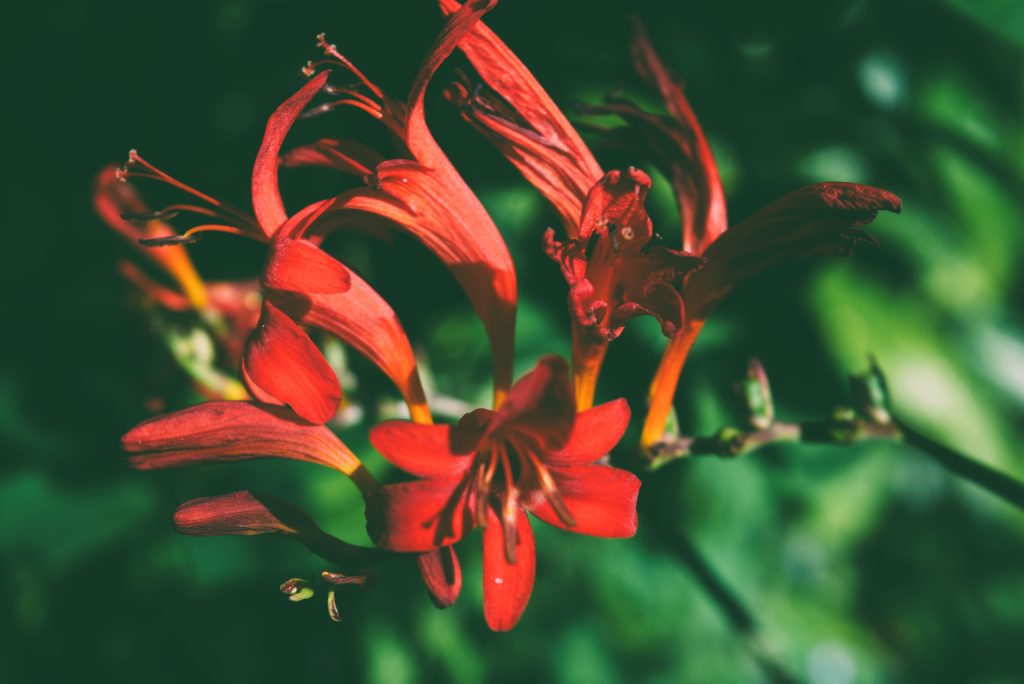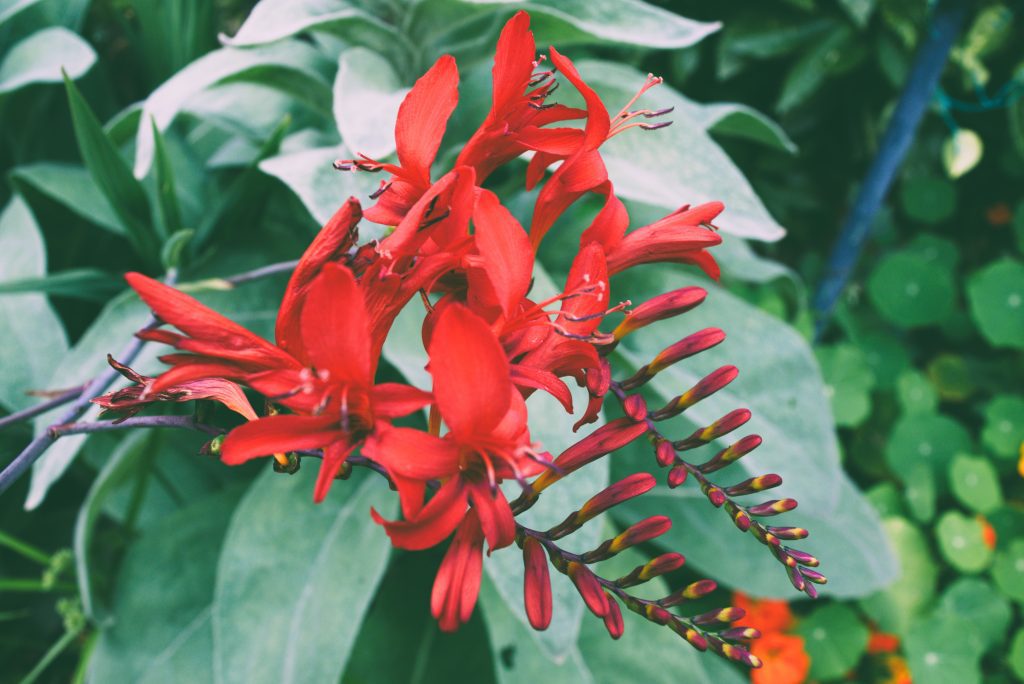Crocosmias, with their vibrant blooms and lush, sword-like foliage, are a staple in many UK tropical gardens. These South African natives, also known as montbretia, bring a touch of the exotic to temperate gardens, creating a striking visual impact with their fiery red, orange, and yellow flowers. Here’s a deep dive into the history, cultivation, varieties, potential issues, and good plant companions associated with growing crocosmias in the UK.
History of Crocosmias in the UK
Crocosmias were first introduced to Europe in the late 19th century, quickly gaining popularity for their ornamental value. The name “Crocosmia” comes from the Greek words “krokos” (saffron) and “osme” (smell), referring to the saffron-like scent released when the dried flowers are placed in water. By the early 20th century, they had become a common feature in British gardens, appreciated for their resilience and ability to thrive in the UK’s varied climate.

How to Grow Crocosmias
Growing crocosmias in the UK is relatively straightforward, provided they are given the right conditions:
- Planting: Crocosmias are usually planted as corms in spring, after the last frost. They should be planted 8-10 cm deep and 10-15 cm apart in well-drained soil.
- Location: These plants thrive in full sun to partial shade. While they can tolerate some shade, their flower production will be best in sunnier spots.
- Soil: Crocosmias prefer slightly acidic to neutral soil. Adding compost or well-rotted manure can improve soil fertility and drainage.
- Watering: Regular watering is essential during the growing season, especially in dry spells. However, avoid waterlogging, which can cause corm rot.
- Maintenance: Deadheading spent flowers and cutting back foliage after it dies down in autumn helps maintain plant health and appearance. In colder regions, mulching in winter can protect corms from frost.
Popular Varieties of Crocosmias
Several crocosmia varieties are popular among UK gardeners:
- Crocosmia ‘Lucifer’: Known for its brilliant red flowers and tall, arching stems, ‘Lucifer’ is a favorite for its dramatic presence.
- Crocosmia ‘Emily McKenzie’: This variety features striking orange flowers with a red throat, adding a splash of warmth to the garden.
- Crocosmia ‘George Davidson’: With its bright yellow flowers, this variety is ideal for adding a golden glow to borders.
- Crocosmia ‘Star of the East’: A later bloomer, it has large, soft orange flowers that stand out in the late summer garden.

Problems and Pests
While generally hardy and low-maintenance, crocosmias can face a few issues:
- Corm Rot: Poor drainage or overly wet conditions can lead to corm rot. Ensuring well-drained soil and avoiding overwatering can prevent this.
- Red Spider Mites: These pests can cause speckled foliage and weakened plants. Regular inspection and the use of miticides or biological controls can keep them at bay.
- Fungal Diseases: Rust and other fungal diseases can affect crocosmias, especially in damp conditions. Proper spacing and good air circulation can help prevent these issues.
Invasiveness of Crocosmias
One of the significant concerns with crocosmias is their potential invasiveness. In some areas, particularly in the milder western parts of the UK, crocosmias can spread aggressively, forming dense clumps that outcompete native plants. Crocosmia x crocosmiiflora, a hybrid species, is particularly notorious for its invasive nature.
To manage their spread, gardeners should:
- Divide clumps: Regularly dig up and divide crocosmias every few years to control their spread.
- Remove seed heads: Prevent self-seeding by cutting back flower stalks before they set seed.
- Dispose of unwanted plants properly: Do not compost crocosmia corms or seeds; instead, dispose of them in green waste bins to prevent them from taking root elsewhere.
Good Plant Companions for Crocosmias
Pairing crocosmias with complementary plants can enhance the tropical effect in your garden and create a visually appealing landscape. Here are some excellent companions for crocosmias:
- Cannas: With their large, bold leaves and bright flowers, cannas add height and a lush, tropical feel that complements crocosmias beautifully.
- Hedychium (Ginger Lily): These exotic flowers add fragrance and striking blooms that harmonize well with the fiery colors of crocosmias.
- Banana Plants (Musa spp.): Their large, dramatic leaves provide a tropical backdrop that accentuates the vibrant colors of crocosmias.
- Dahlias: Especially those with bold, warm colors, dahlias can match the vibrancy of crocosmias, creating a rich tapestry of color.
- Hostas: For a contrasting foliage texture, hostas can provide a lush, green backdrop that highlights the bright crocosmia blooms.
- Tithonia (Mexican Sunflower): Their orange flowers pair well with the fiery hues of crocosmias, creating a vibrant summer display.
- Agapanthus: With their blue or white globe-like flowers, agapanthus provides a cool contrast to the hot colors of crocosmias, balancing the overall palette.
- Hydrangea arborescens ‘Annabelle’ or ‘Limelight’: These hydrangeas with their large, white flower heads offer a stunning contrast to the fiery colors of crocosmias. Their lush, green foliage and big blooms create a dramatic and elegant background that enhances the tropical aesthetic.
Conclusion
Crocosmias are a vibrant addition to any UK tropical garden, offering exotic flair with their stunning blooms. With proper care and management, they can thrive without becoming a nuisance. By selecting suitable varieties, pairing them with complementary plants like hydrangeas ‘Annabelle’ or ‘Limelight’, and staying vigilant about their spread, gardeners can enjoy the fiery beauty of crocosmias while maintaining a balanced and diverse garden ecosystem.
